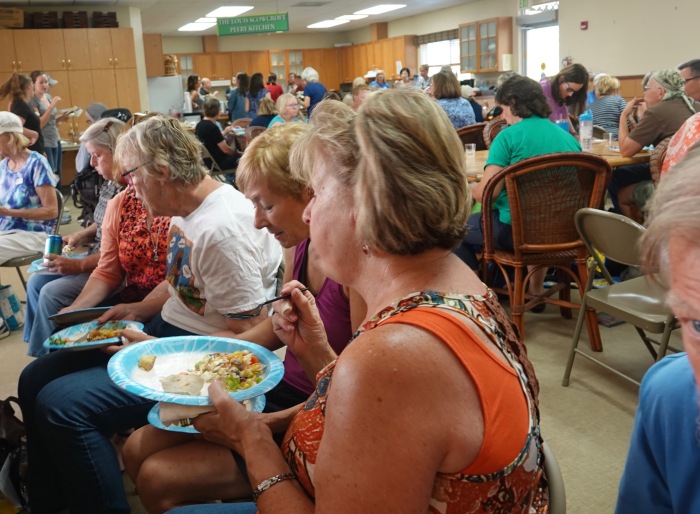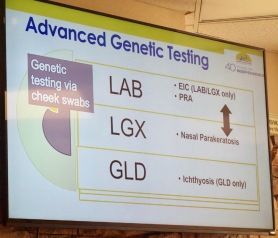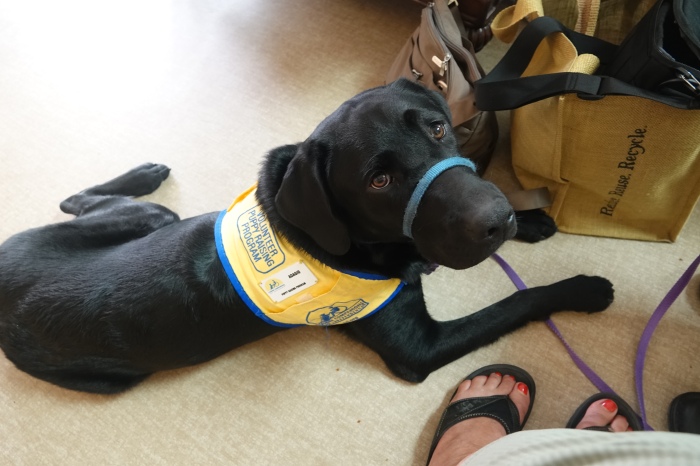
Adagio had to be neutered (last week). Brando (our third CCI puppy and the only one, so far, to graduate) also underwent castration at a tender age. That’s unlike Tucker, our first CCI puppy, whom we adopted when he was released for distractibility. (He’s now approaching his 14th birthday). Tuck wasn’t neutered until after he was in Advanced Training. Like him, none of the 5 female CCI puppies we’ve raised had to be spayed until after they left us.
Why the inconsistency? What we’ve been told over the years is that all female CCI puppies — whether they’re pure-bred labrador retrievers or golden retrievers or some cross of the two — may be chosen for CCI’s breeding program. The decision about whether birthing more CCI puppies will be their mission in life is not made until after they’ve reached the advanced phase of their training. In contrast, CCI only uses purebred labs or goldens as studs, and Tucker (100% labrador) was the only male we’ve had who met that qualification.
Okay.
But why only mate purebred males with all those cross-bred females? Steve and I had never heard any explanation for that until yesterday, when we attended a presentation by Esther Molina, the director of CCI’s national breeding program, based at CCI headquarters in northern California. Since she was in town, the staff at the Southwest Regional headquarters in Oceanside invited local puppy-raisers to a potluck dinner and informational program featuring her.
A 23-year veteran with the organization, Molina has both raised CCI puppies and served as a breeder-caretaker before taking over direction of the national breeding program. She told us that some 70-80 females are producing litters at any given time. The girls require the services of only 29-40 males.
From what Molina said, it sounds like the decisions about who to mate with whom are exceedingly complex. But the organization now has vast amounts of multi-generational data to help guide it. A top priority is doing everything possible to breed healthy dogs. Any hint of a predisposition to hip, heart, or eye problems will disqualify the animal for reproduction, and advanced genetic testing is now enabling CCI to eliminate certain  problems common in labs and goldens (e.g. exercise-induced collapse and progressive retinal atrophy).
problems common in labs and goldens (e.g. exercise-induced collapse and progressive retinal atrophy).
Producing dogs with the perfect personality to be service animals is even more of a challenge. To do that more consistently, Molina said CCI is now testing canine cognitive ability and assessing the results across generations. It sounds like this is very much still a work in progress.
During the Q&A session, I asked my question about why only studs have to be purebreds (and not the dams too). Molina’s basic answer was that this policy simplifies life and makes it possible to preserve the characteristics of each of the two breeds used by the organization. If CCI bred lab-golden crosses (LGXs) with other LGXs for generation after generation, the results would soon be a separate LGX breed — a breed whose characteristics were less well understood than the original two.
At least I think that’s what she was saying. Molina spoke for a disappointingly small percentage of the program time. Steve and I had the impression that the large audience of puppy-raisers happily would have peppered the breeding program director with enough questions to make for a fascinating hour beyond what she was.
 Adagio, on the other hand, found our outing a bit taxing. He maintained a Down position nicely while we ate our servings from the potluck, but during the presentations he popped to his feet far too often. He’s been suffering from some minor intestinal upset, so it may have been that which made him want to jump up and go.
Adagio, on the other hand, found our outing a bit taxing. He maintained a Down position nicely while we ate our servings from the potluck, but during the presentations he popped to his feet far too often. He’s been suffering from some minor intestinal upset, so it may have been that which made him want to jump up and go.
I had no idea how much research went into producing the right CCI puppies. I need to treat Adagio with more respect.
LikeLike
Respect would baffle him. Hugs and pats on the head are what HE appreciates most.
LikeLike